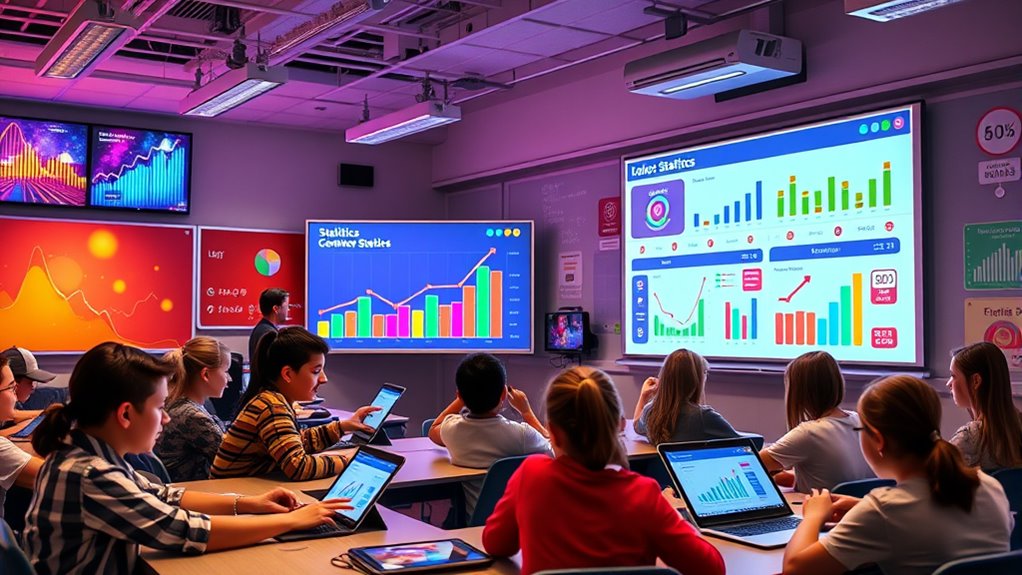To gamify statistics like a pro, turn complex data concepts into fun, interactive activities like quizzes with instant feedback. Use leaderboards and progress tracking to motivate yourself and foster a sense of community. Set personal goals and challenge friends to keep things fresh and engaging. Active participation boosts retention, confidence, and enjoyment. Keep exploring different tactics, and you’ll discover even more ways to make learning statistics exciting and rewarding.
Key Takeaways
- Transform complex statistical concepts into interactive quizzes with instant feedback to enhance engagement and understanding.
- Incorporate leaderboards and friendly competitions to motivate learners and foster a sense of community.
- Use goal setting and progress tracking to break down topics, boosting confidence and sustained participation.
- Provide personalized challenges and peer comparisons to keep learning fresh, challenging, and tailored to individual paces.
- Reinforce learning through immediate rewards, active participation, and social elements, making statistics learning both fun and effective.

Gamification of statistics transforms complex data concepts into engaging, interactive experiences that make learning both fun and effective. Instead of passively reading through charts and formulas, you actively participate in the process by tackling interactive quizzes that test your understanding in real time. These quizzes turn dry statistical topics into lively challenges, encouraging you to apply concepts immediately and see results instantly. When you get a question right, you feel a sense of achievement, which motivates you to keep going and master more advanced ideas. If you stumble, the immediate feedback helps you identify gaps, making the learning process more personalized and less intimidating.
To level up your engagement even further, leaderboard strategies come into play. By integrating leaderboards into your learning system, you create a friendly competition that pushes you to improve your scores and understand concepts more deeply. Seeing your name climb the ranks or comparing your progress with peers adds an extra layer of motivation. Leaderboards foster a sense of community, where learners challenge each other in a supportive environment. You’re not just memorizing formulas; you’re actively aiming to outperform yourself and others, which makes studying statistics less of a chore and more of an exciting game.
Incorporating these strategies into your study routine means you’re constantly setting goals and tracking progress, which helps break down intimidating topics into manageable chunks. For example, completing a series of quizzes on probability or regression analysis, then seeing your ranking improve, reinforces your confidence. You start to view statistical concepts not as abstract or overwhelming but as achievable milestones. The competitive element encourages consistent practice, which is vital for mastering complex data analysis skills. Research shows that interactive learning tools significantly enhance retention and understanding, making the process more effective.
Furthermore, gamification’s dynamic nature means you can customize your experience. You might choose specific topics to focus on, set personal best scores, or challenge friends to beat your streaks. This flexibility keeps your learning fresh and tailored to your pace. Over time, the combination of interactive quizzes and leaderboard strategies creates a habit of active engagement, transforming how you approach statistics from a formidable subject into an enjoyable pursuit. By leveraging these tools, you’ll develop a deeper understanding, retain concepts longer, and boost your confidence to handle real-world data challenges with ease. Gamification isn’t just about making statistics fun; it’s about making you a more effective, motivated learner who’s enthusiastic to conquer data analysis like a pro.
Frequently Asked Questions
How Can Gamification Improve Learning Retention in Statistics?
You can boost learning retention in statistics through effective game design that makes concepts engaging and interactive. Gamification encourages student engagement by turning lessons into challenges and rewards, motivating you to participate actively. This method helps solidify understanding by providing immediate feedback and fostering a sense of accomplishment. As a result, you’re more likely to remember complex statistical ideas and stay motivated to learn, making the process both fun and effective.
What Are the Most Effective Gamification Tools for Statistics Education?
You can boost your statistics learning by using effective gamification tools like interactive simulations and badge systems. Interactive simulations make complex concepts easier to grasp through hands-on experience, keeping you engaged. Badge systems motivate you to complete milestones and track your progress. These tools turn learning into an enjoyable challenge, helping you retain concepts better and stay motivated throughout your educational journey.
Can Gamification Motivate Students With Varying Skill Levels?
Ever wondered if gamification can bridge motivation differences among students? You can boost engagement strategies by tailoring game elements to suit various skill levels, making learning accessible and fun for everyone. By incorporating challenges that adapt to individual progress, you motivate students across the spectrum. This personalized approach keeps students engaged, fosters confidence, and encourages continuous learning, proving that gamification can effectively motivate students with varying skill levels when designed thoughtfully.
How Do You Measure Success in Gamified Statistics Programs?
You measure success in gamified statistics programs by tracking performance metrics like quiz scores, completion rates, and skill improvements. User engagement is vital—look at how often students participate, their enthusiasm, and time spent on activities. If these indicators improve over time, it shows the gamification effectively motivates and educates. Regular assessments and feedback help guarantee the program adapts to student needs, boosting overall learning outcomes.
Are There Any Risks or Drawbacks to Gamifying Statistics Learning?
You should consider that gamifying statistics learning can lead to overconfidence bias, making learners overestimate their skills and overlook complex concepts. Additionally, distraction risks increase if game elements overshadow core content, reducing focus. While gamification boosts engagement, it’s essential to balance fun with meaningful learning, ensuring learners stay attentive and humble about their knowledge, and avoid becoming overly reliant on entertainment rather than understanding.
Conclusion
By gamifying statistics, you turn learning into an engaging experience. For example, did you know that students who play educational games improve their understanding by 30%? Visualizing data through interactive elements makes complex ideas easier to grasp and more memorable. So, next time you delve into stats, think like a gamer—making the process fun, visual, and impactful. Embrace gamification, and you’ll master data like a pro in no time.










